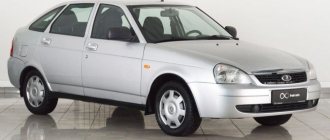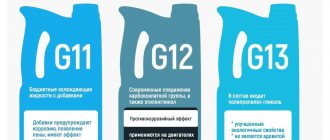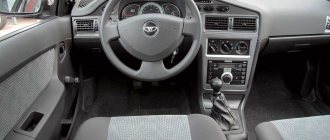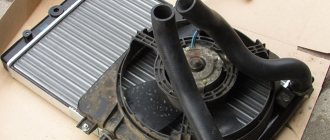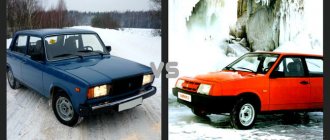I share my experience in choosing Samaras when purchasing. My father has a friend who has been driving eights all his life, they shared this experience with me + some of my observations.
By year of release:
— before ’95 it’s normal — from 95 to 98 — the body metal is different, it rusts a lot — after ’98 — it’s normal
By body:
In addition to the absence of rust on the sills, bottom and surfaces, check for the presence of new body parts: - at the joints of panels, doors and sidewalls, fenders, windshield frame, etc. there should be no steps (we saw a copy with a welded roof) - scratched bolts of the front fenders indicate that they were removed (this is not visible on a fully painted car) - if you look at the bottom, you can see traces of welded side members, sills and patches (we saw fresh mastic around the thresholds on one copy).
emphasize on:
- rear fenders on the outside, near the wheels (if there are traces of corrosion, THIS IS MOST LIKELY THROUGH-THROUGH, because the fenders rust in this place from the inside) - lower corners and edges of the doors (accumulated moisture can damage them) - not on the lower edge of the rear door there should be rust (like doors, it rusts from the inside) - DOOR PLAYS (take the open door from the end, shake it - there should be no play, in practice it turned out that the heavy silent door of the eight does not play, but when closing it overcomes a finger-thick step, which indicates a sagging loop) - the frame and pillars of the windshield are a disease, they rust from the inside (they are blown out with anticorrosive, in this case the front panel and pillar trims are removed =>
already blew out the pillars on mine, a can of Movil with a 360′ spray was used
) - rear frame glass, (to treat it with anti-corrosion from the inside, the glass is removed, without it, by the way, the back door loses much rigidity), it can rust under the rubber band, in this case, after treatment, the glass with the rubber band is placed on a sealant. — the glass rubber bands should lie symmetrically, the opposite case may indicate their careless replacement (+scratches around the glass) and possibly a damaged body. - the gaps of the hood and the rear door must be symmetrical on the left and right - The fastenings of the front panel to the body should not be broken (located near the hinges of the front doors), although this can be treated - “crabs” (the very front fastenings of the front suspension braces): all three must be present bolts, the body around them should not be overcooked (they cannot be overtightened, otherwise the bolts will spin and you have to open the body around them to get to them)
Also check:
— Seals for front wheel drives and gear shifts. Climb under the car and look from below, in the places where these 3 drives enter the box there should be no oil leaks - the rubber bands on the CV joints, gear shift drive and steering rack should be intact. - front and rear suspension struts must be DRY - otherwise, replace.
Sea trials:
Not to mention the ease and clarity of gear shifting, extraneous noise in the gearbox and engine, clutch operation, etc. 1. Ride relatively quickly through sharp holes: The stand, falling into a hole, is stretched by a spring before touching the ground. If a knock occurs, the racks are finished; they should stretch slowly and contract quickly. 2. Turn the steering wheel all the way and turn with the throttle in both directions: CV joints in the wheel drives should not crunch! Otherwise - replacement. In ordinary life you shouldn't do this. (although there are people who drove for six months with crunchy grenades, but how long have they been crunchy for the previous owner?)) 3. When accelerating sharply, a hum may appear in the hub bearings (tested on a fellow student’s car, both of them were humming at the rear) 4 . Turn on the reverse gear, for another classmate on 21099 it stopped engaging altogether. Everything was solved with a repair kit for the gearbox (the plastic guide (I forgot what it’s called) for the reverse gear was worn out)
Compression check:
Even with a compression of 6 atmospheres, the car can drive, so it is necessary to check it, especially with runs over 100 thousand km. A separate case is abandoned one- or two-year-old cars with expired mileage. the minimum indicator is 9.5 - 10 atm. compression between cylinders should not differ by more than 0.5-1 atm. On a cold engine it is slightly less than on a hot one - keep this in mind.
Checking the carburetor engine:
1.Remove the central high-voltage wire from the ignition distributor, unplug the hall sensor connector. 2. Turn out all the spark plugs, insert a compression gauge instead of one 3. Turn the starter, the compression gauge needle rises jerkily and stops - this is the result, stop the starter. 4. Repeat for the remaining cylinders, the 3rd and 4th cylinders may be a little worse - this is normal (I assume due to lower oil pressure at the end of the line, but I could be wrong. In longitudinally mounted engines this is observed due to worse cooling (there they are not blown counter air)).
Checking the injection:
1. Unscrew the spark plugs 2. Insert a compression gauge instead of one 3. Press the gas to the floor and turn the engine with the starter (this turns on the spark plug blowing mode, fuel does not enter the cylinders).
BUT we simply pull out the connector of the crankshaft position sensor (it is on the side where the timing belt is) at the same time (no spark, no fuel - everything is safe) 4. Repeat for the remaining cylinders. *yes, if the compression readings vary greatly between cylinders, or are less than expected, it may be worth washing the injectors on the car connected to the fuel rail (Vynn's cleans injectors, combustion chamber, rings, but kills spark plugs)
And about ringing ads:
Before the call, we determine a number of mandatory criteria (I provided mine): - mileage? after 150-200 thousand km they were eliminated, because the engine has a certain resource - how many owners? preferably 1-2 - not broken, not painted? did you change the engine/gearbox? -if yes, then the car was clearly killed, the rest may be in the same condition. Eights are basically all broken and painted, even if they say the opposite) - are there anti-corrosion and fender liners? if not, then most likely it has already rusted over the years (the anticorrosive agent should be updated every two years)
Which car is better to take: VAZ 2115 or Daewoo Nexia?
Not everyone can afford to buy an expensive, high-class car. And some people prefer to buy budget cars for trips to their dachas or to gain driving experience. But even here you need to carefully consider what is best to choose, paying special attention to the technical characteristics. A good option is the VAZ 2115 and Daewoo Nexia. Disputes often arise among car enthusiasts about which of these cars is more reliable. To dispel doubts, you should study their features, as well as compare the main parameters.
General parameters and components of Daewoo Nexia and 2114
- The type of fuel used is gasoline, it is possible to install LPG.
- Both cars are front-wheel drive, with a five-speed manual transmission.
- The engine volume in both models, but different years of production, differs slightly - 1.5 liters and 1.6 liters.
- The maximum permissible speed of the “fourteenth” is 157 km/h , and for Daewoo it is 163 km/h . We’ll write it down here, since the difference of 5 km/h is insignificant, and it’s prohibited by traffic regulations to reach such a speed.
- The technical characteristics of the suspension are similar in many ways: both cars have MacPherson strut suspension at the front, and a longitudinal wishbone suspension at the rear.
- A classic braking system is installed: disc brakes in front, drum brakes on the rear wheels.
VAZ 2115
It is a subcompact five-seater small group car owned by the Russian automobile manufacturer AvtoVAZ. Produced from 1997 to 2012. It was produced as a sedan with a front-wheel drive layout. Powered by a four-cylinder gasoline engine and equipped with a five-speed manual transmission.
It differs significantly from its predecessor in the modified body on the rear side - the trunk lid, lighting devices. The hood and front fenders were rounded, the bumpers were also changed, an additional brake light and moldings were added. In addition, the interior was completely renovated and the electrical equipment was modernized. The shape of the car has become streamlined, making the look more modern. We have also improved loading things into the trunk, making the loading height more comfortable.
Basic equipment includes:
- Electric rear window defroster.
- Electric windows for front doors.
- Electromechanical door locks.
- On-board control device with display unit.
- Electronic anti-theft device.
- Individual lighting lamp.
- Fog lights.
- Stuffing the backs of the front seats with plant contents.
- Head restraints in the rear seats.
- Trunk trim.
The next version is equipped with anti-dazzle exterior mirrors, heated front seats, and a sun visor with a mirror. The maximum configuration includes a catalytic converter, a device for catching gasoline vapors, a headlight washer, electric exterior mirrors, and tinted windows.
Daewoo Nexia
It is a front-wheel drive car developed by the German manufacturer Opel and subsequently improved by the Korean company Daewoo. Produced from 1996 to 2016. Available in sedan, three-door and five-door hatchback versions. It has a five-speed manual as well as a four-speed automatic transmission.
First generation cars were sold in two trim levels - basic and advanced. The extended version had an improved appearance and was equipped with decorative wheel covers. After restyling, the body changed significantly, the engine became modernized. The front and rear bumpers and optics were updated, the interior was changed, and shockproof beams were added on the doors.
Standard equipment includes:
- Seat belt not fastened indicator.
- Electrical adjustment of headlights.
- Protecting doors from accidental opening by children.
- Headrests in the rear seats.
- Dashboard with clock.
- Glove box.
- Trunk light.
- Remote trunk opening.
- Rear window defogger.
- Wipers with adjustable pause.
- Sun visor with mirror.
- Rear fog lamp.
- Set of tools.
More expensive versions are equipped with centralized locking, hydraulic power steering, air conditioning, car radio, power windows on all doors, and acoustic speakers. There are mudguards, exterior mirrors with turn signal repeaters. It is also possible to install sun protection film on the windshield and athermal glass.
Which car is better?
If fuel economy comes first, then you need to buy Nexia. In the city or on the highway, it doesn’t matter, this car “eats” one liter less than the fourteenth model. Power steering makes the car more maneuverable, which helps when driving in urban conditions. The presence of the ABS system increases braking safety. Choosing a foreign car is necessary for those who value comfort and reliability.
Those who plan to spend more time on the highway and at high speeds should choose the VAZ 2114. Also, domestic cars are more passable due to their higher ground clearance. The car is unpretentious in repair and maintenance; most operations can be carried out in the garage. This car should be chosen by those who are not willing to pay dearly for maintenance and repairs.
Auto and motorcycleComment
Comparison, differences, what to choose
When there is a choice between the two options under consideration, of course, everyone will be interested not only in the presence of similarities, but also in the differences. The main ones include:
- The length, width of the body, as well as the wheelbase of the first car are smaller than those of its competitor. But it has more height and ground clearance.
- The VAZ 2115 is available only in a sedan body. In the second case, in addition to the sedan, there is a three-door and five-door hatchback.
- The volume of the luggage compartment of the VAZ 2115 is 427 liters. The second machine can hold up to 530 liters.
- The domestic car is equipped only with a five-speed manual transmission. The Daewoo Nexia additionally has an option with a four-speed automatic transmission.
- In terms of efficiency, the VAZ 2115 wins. Its consumption in the city is about 7 liters per 100 km/h. The second car spends about 8 liters of fuel.
- The acceleration time of the first car from 0 to 100 km/h is 14 seconds. Daewoo Nexia accelerates several seconds faster.
Based on the above, it is clear that both cars have their advantages and disadvantages. According to some parameters, the domestic car wins, while according to others, the foreign car wins. But still, by a slight margin, Daewoo Nexia has more advantages. In addition, it has a more modern appearance, and all the switches and buttons work without jamming, which is not the case with its rival. But the point of purchasing a Daewoo Nexia will only be if you buy the maximum configuration, since the basic version looks too meager. The VAZ 2115 is perfect for novice drivers, as well as those who like to do tuning.
Where to choose
Each buyer must decide for himself which car is best for him. This depends on a number of factors, so you need to build on not one, but several of the most important criteria.
Summing up the comparison of the VAZ-2109 and VAZ-2114, we can draw the following conclusions:
- the fourteenth model is an improvement on the “nine”, but in no way a transition to a completely new car or a serious revolution in the field of the domestic automotive industry;
- The VAZ-2114 received a modified front part of the body, which became more interesting and attractive, but lost the reliability of the bumper;
- the fourteenth VAZ has a new dashboard, which brings the car closer to the European level in terms of comfort and simply in appearance;
- cars were assembled at different enterprises, which is why even identical cars sometimes turn out to be of unequal quality;
- The VAZ-2114 was made with the goal of getting closer to European quality standards and giving the car a laconic, interesting and dynamic appearance;
- The VAZ-2109 remains one of the most reliable domestic cars, which continue to be in great demand.
We can say with almost 100% confidence that the release of 2114 did not fully meet the automaker’s expectations. AvtoVAZ wanted to make this car a worthy replacement for the legendary “Nine”, which would satisfy the needs of modern consumers and be able to compete with imported cars. The result was almost the same VAZ-2109, but with a changed appearance and a modernized interior. The essence remains the same. Especially until the manufacturer decided to add a 16-valve engine to the line.
If you want a “nine” with a more attractive design, excellent tuning capabilities and electric windows, but are willing to pay a little more, you should definitely take the VAZ-2114. Only experienced motorists strongly recommend in this case to take the version only with a new engine. In combination with eight-valve engines, the fourteenth model loses a number of its advantages. For people who need a structurally simple, reliable and durable car, although deprived of some of the charms of European-style cars, the “nine” is perfect. In addition, now there are many ways to transform the car yourself, install the same electric windows with your own hands, change the appearance and add various types of equipment to the interior. The VAZ-2109 is cheaper, but in fact it is not much inferior to its successor.
Make the decision yourself. Much depends on the condition in which you find the car. In this regard, we will add that it is better to take a “nine” in excellent condition than to buy a VAZ-2114 for the same money with obvious problems with the body or engine.
Good day! Please help me choose between the VAZ 2109, 21099 and Lanos. BOO. The soul lies most with the vase, but many friends recommend Lanos more, they say, it will be more comfortable. It is interesting to know the opinions of people who have been in this mess. Thank you in advance, everyone, and if it doesn’t hurt, be more specific.
Which is better VAZ or NEXIA? Comparison
A novice car enthusiast wants to buy his first car as soon as possible. But before buying, it is better to carefully familiarize yourself with the options that you can afford. As a rule, everyone starts with inexpensive cars, then the ideal option in this category would be VAZ, Nexia. But often beginners ask questions “what is better to buy a VAZ or Nexia?” You will find out the answer to the eternal question Nexia or VAZ by reading this article.
Comparison of VAZ and NEXIA
In one corner of the ring we will have a Daewoo Nexia, and in the other corner there will be an AvtoVAZ and the following models will take the rap for it: VAZ 2112 (two), VAZ 2114 (four), VAZ 2115 (fifteen) and VAZ 2110 (ten).
About VAZ - pros and cons
In our price category, almost all the popular fret models of past years are at once - from ten to fifteen. There are no significant differences between the models in equipment, only the appearance differs. Therefore, it makes no sense to compare the appearance of cars from Togliatti, just look at them:
Appearance of dozens of VAZ 2110
Appearance of two VAZ 2112
Appearance of the four VAZ 2114
Appearance of the tag VAZ 2115
Our cars look like the poor 90s, but despite the very outdated design, they are respected by the people. In almost every yard you can find one of these models, a particularly popular car among young people. The appearance is not repulsive, but the attitude towards the car is specific - everyone will know that you have little money.
There are exceptions to the rules; due to its popularity, tuning a VAZ is much easier. Shops with Chinese headlights or muffler tips are on every corner, as well as many popular movements such as loundsound and BPAN.
About Nexia - pros and cons
Nexia is not far behind in its popularity. In 2014, Daewoo cars were recognized as the best-selling cars in Russia. The first thing you need to know is that Nexia is a foreign car. Yes, no matter how you want it - the car was designed in Germany, finalized in South Korea, and produced in Uzbekistan. A big plus compared to other foreign cars is the price.
The new Nexia at one time did not cost much more than the new VAZ, so the choice is often obvious. For the same money we will get more reliable time-tested components and assemblies. Steering wheel, electric windows, air conditioning are practically standard. The appearance of the Daewoo is about the same time as our cars, but the restyling, at least from the front, looks advantageous.
Appearance of Nexia N100
Appearance of Nexia N150
Agree, the front end is not bad.
Comparison of VAZ and Nexia
Comparison of these cars needs to start with dry numbers, namely technical characteristics. Comparison table between VAZ and NEXIA:
Main differences and comparison of cars
At first glance, it is not so easy to find the differences between these two domestic cars. This is understandable, since the VAZ-2114 replaced the VAZ-2109 as a modernized, improved version of its predecessor. This is not a transition to a completely new model. Nowadays such transformations are usually called restyling. The VAZ-2114 does not reach the level of a new generation car, since it has too much in common with the “nine”. The car is different, but in less significant parameters, according to experts and motorists. But you can compare the VAZ-2114 and 2109. If you carefully study the features of the two cars produced by the Russian company, you will understand how they differ from each other.
Having compared the VAZ-2109 and VAZ-2114, we come to the following conclusions:
- The new version of the “nine”, called VAZ-2114, has undergone changes inside and out. New headlights appeared on the body, a new lining was made on the radiator grille, and the front bumper and hood were somewhat modernized. Also on the fourteenth model, stylish and fashionable moldings were installed at that time.
- The VAZ-2109 or simply “nine” boasts an indestructible, practically invulnerable front bumper. But when developing the fourteenth VAZ, engineers lost sight of this component, as a result of which the predecessor’s bumper is considered better than that of its successor.
- Serious changes affected the front panel, if we move on to the internal equipment of the VAZ-2114. The new control panel has been adapted to European standards. Because the inside of the car looks more attractive, everything looks concise, logical and stylish. But the “nine” retained the Soviet-style panel, which has neither style nor any intelligible logic. They installed everything that was required for the car, but the engineers and designers didn’t think much about how they installed it. The main thing is that it is.
- VAZ-2114 was electrified. The primary innovation was the installation of electric front windows. Finally, the owners of domestic cars felt what it was like not to turn the oars, but to raise and lower the window by simply pressing a button.
- The heir to the legendary “nine” tried to outdo its predecessor and attract more audience by installing a new steering wheel and an adjustable steering column. Although in terms of the steering wheel, the engineers did not come up with anything new, but simply borrowed this element from another VAZ. Namely, the VAZ-2110, or simply “tens”.
- Internal changes to the fourteenth model made the interior more modern, interesting and functional. Although fans of the old school believe that the interior of the “nine” was more reliable. This is rather a matter of habit, since a modern person wants to get at least some relevant automotive benefits. In this component, 2114 is noticeably ahead of 2109.
- The engine compartment has also been modernized. Eight-valve gasoline engines with four cylinders were installed on the “nines” from the factory. Depending on the configuration, the client could order a power unit with a volume of 1.1, 1.3 and 1.5 liters. Nothing bad can be said about the engines, but these are frankly outdated engines. No more. In the case of the fourteenth model, new engines began to be installed. To be more precise, there was initially only one engine, borrowed from the “nine”. The line of engines featured only a 1.5-liter power unit. But then the developers took into account their mistake, as a result of which they added a 1.6-liter gasoline 16-valve engine to choose from.
These are the main distinctive features with which you can compare two Russian-made cars. It's important to understand that both cars are workhorses and not luxury or luxury vehicles. If you need a high level of convenience, modern equipment, air conditioning, airbags of various types, then these cars are clearly not for you.
